Other common names:
- Corn chamomile: field chamomile
- Mayweed chamomile: mayweed, stinking chamomile, dog fennel, stink-weed, dogs chamomile, dill weed, stinking daisy, hogs fennel, fetid chamomile, stinking mayweed
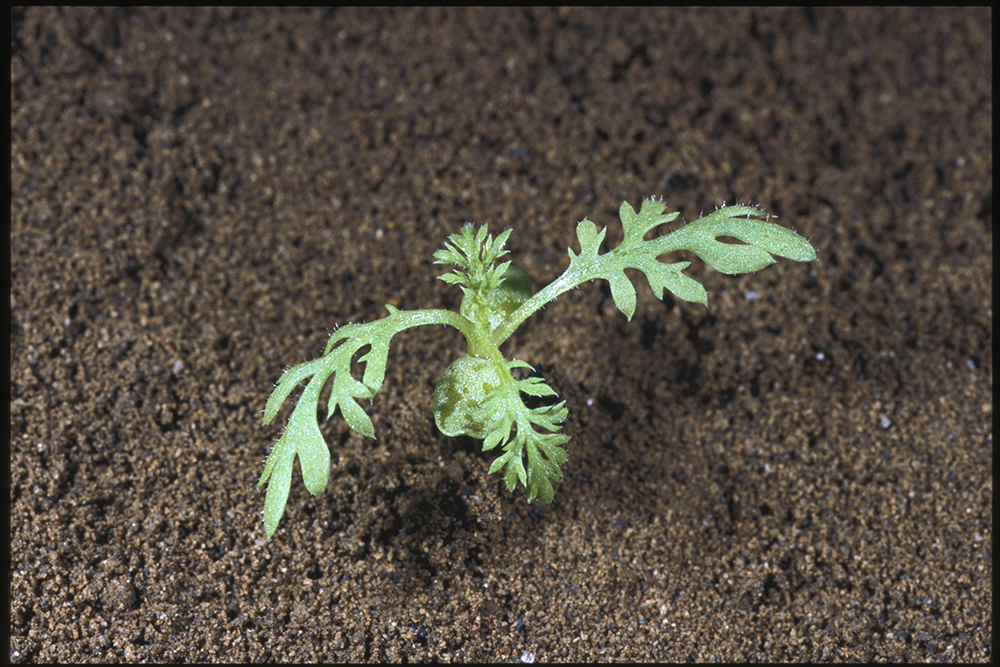
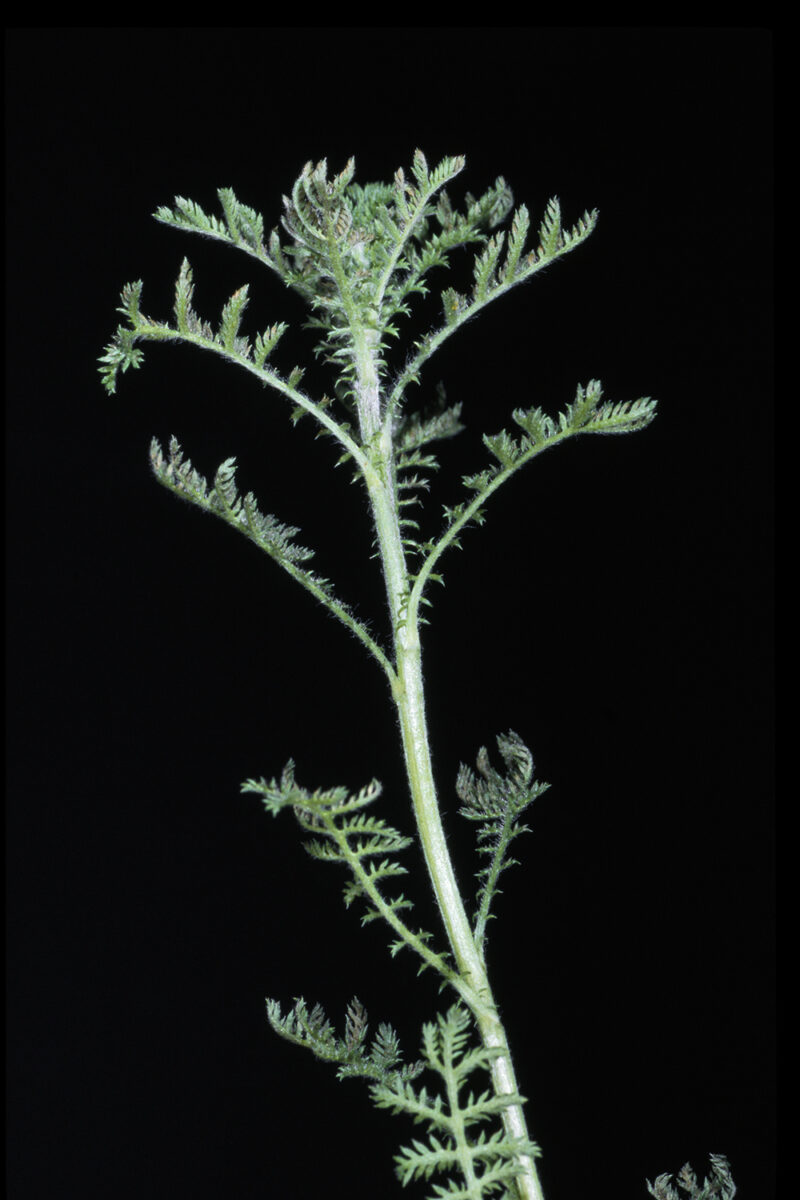
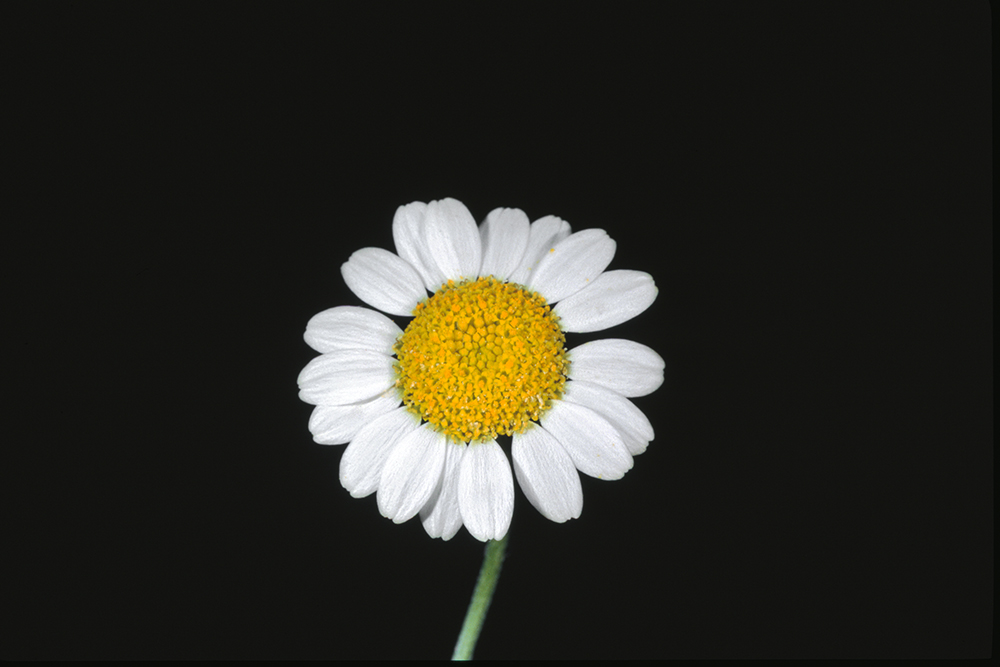
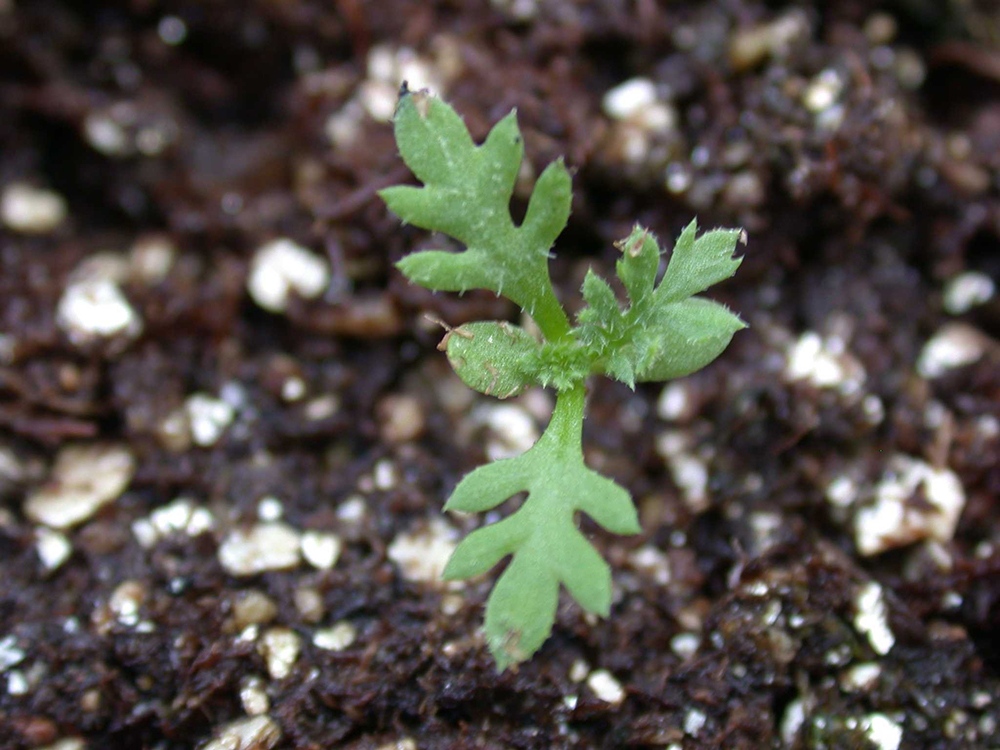
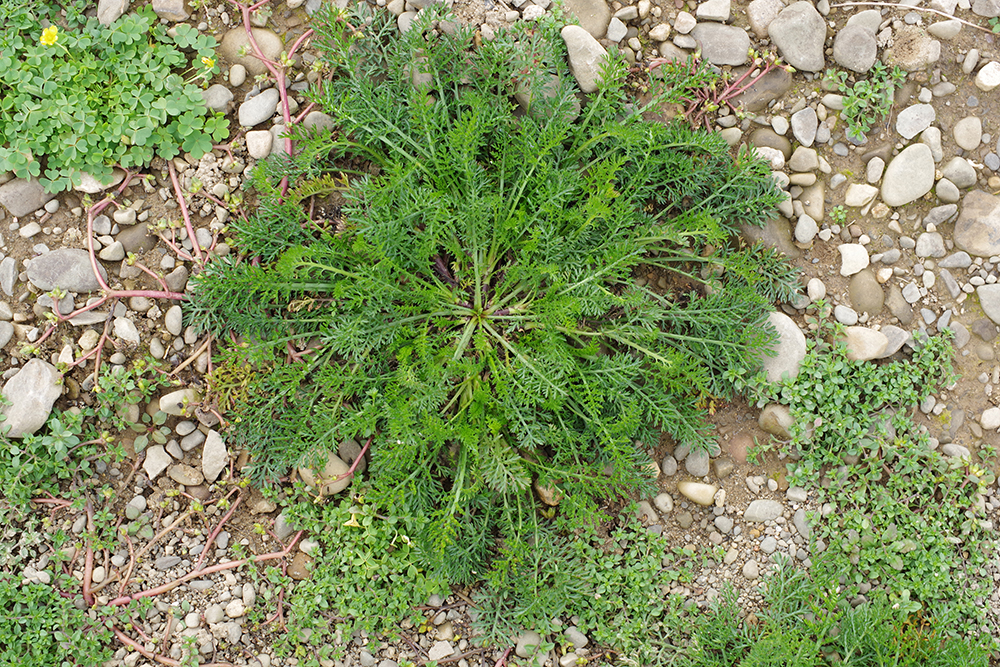
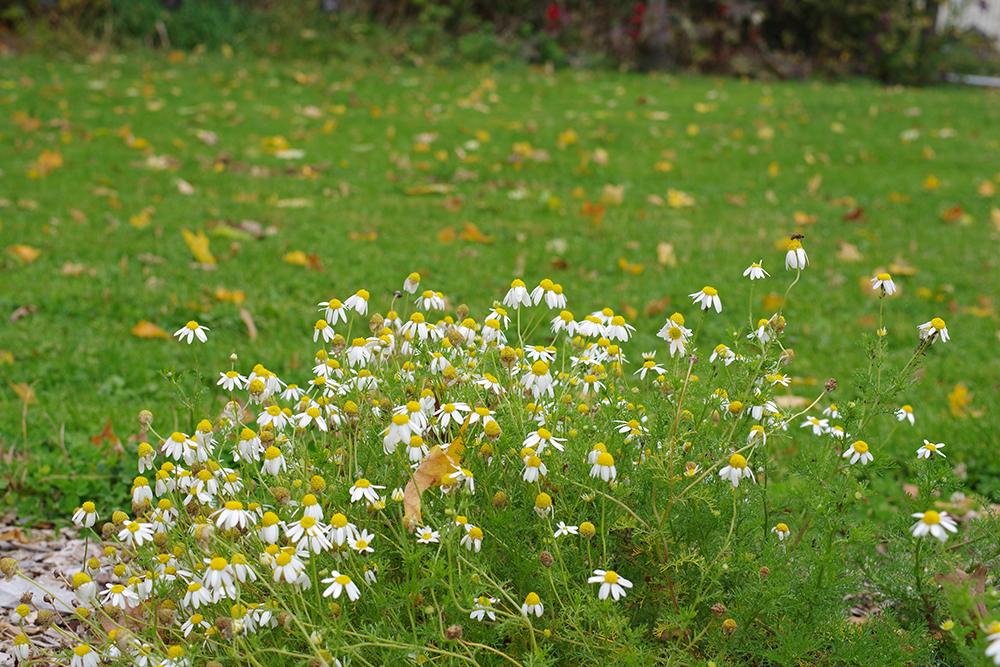
Corn chamomile, Anthemis arvensis L.
Mayweed chamomile, Anthemis cotula L.
Identification of Chamomiles
Family: Aster, Asteraceae
Habit: Upright, branching winter or summer annuals with finely divided leaves
Description: Seedlings have thick, hairless, stalkless, oval shaped cotyledons. The first two leaves are opposite, somewhat thick and divided. Subsequent leaves are thinner, green, lightly hairy, finely divided into leaflets that have smaller lobes, and form a basal rosette. Leaves have a rounded shape; leaflets and lobes are oval or egg shaped.
- Corn chamomile: Cotyledons are light green and 0.1–0.2 inch long; in all other ways the seedling resembles mayweed chamomile.
- Mayweed chamomile: Short-lived cotyledons are 0.3 inch long with obscure veins. The base of the cotyledons is fused to form a fleshy cup. The seedling stem is green to dull maroon. The first pair of true leaves is opposite with short surface hairs; all subsequent leaves are alternate.
Mature plant stems are upright or leaning; they branch just above the rosette and take root at nodes when in contact with soil. Leaves are club- to egg shaped in outline but are divided two to three times into finger-like leaflets and lobes. Fibrous roots extend from short, broad taproots.
- Corn chamomile: Stems are lightly hairy, green, red in strong light and 8–20 inches tall. Leaves are alternate, 0.8–2.4 inches long by 0.4–0.8 inch wide, and leaflet lobes are 0.03 inch wide. Leaflets are less finely divided than mayweed chamomile. Leaves are gray-green and covered in soft hairs.
- Mayweed chamomile: Stems are nearly hairless, green, 4–24 inches tall and highly branched. Leaves are alternate, yellow-green, slightly hairy, 0.5–2.5 inches long by 0.25–1.25 inch wide and very finely divided, with narrow leaflets and lobes. Crushed leaves have a strong, unpleasant odor.
Flower heads are daisy like and comprised of 10–16 small ray flowers with 0.25–0.5 inch-long white petals surrounding a central disk of numerous tiny, yellow flowers. Individual flower heads are located on branch ends; one to two rows of small, tapered, hairy green bracts wrap the base of the flower head.
Seeds are covered with a hard, tight shell of fruit tissue. These seed units are light brown, narrow, four-sided wedges, with 10 longitudinal ribs.
- Corn chamomile: Seeds are smooth, 0.06–0.1 inch long and produced from both flower types. Seeds from ray flowers are larger than seeds from disk flowers.
- Mayweed chamomile: Seeds are bumpy, 0.06 inch long and produced only from yellow disk flowers.
Similar species: The best way to distinguish the chamomiles from closely related species is by scent, since the entire plant when crushed will exude a distinctive odor at all growth stages. Corn chamomile is lightly chamomile scented, while mayweed chamomile has a strong foul odor. Scentless chamomile [Tripleurospermum perforatum (Mérat) M. Lainz, formerly Matricaria perforata Mérat] and yellow chamomile (Anthemis tinctoria L.) both lack noticeable odors. Scentless chamomile has white flowers, and yellow chamomile has yellow flowers. Pineapple-weed [Matricaria discoidea DC., formerly M. matricarioides (Less.) Porter] has a petal-less, cone shaped, yellow-green flower head, and its foliage smells like pineapple.
Management of Chamomiles
Following sound general weed management principles should keep these species under control. In particular, relieve soil compaction, and if mayweed chamomile is a problem, consider steps to improve soil drainage as well. This will tip the competitive balance in favor of the crops and also improve the success of cultivation. Timely rotary hoeing and tine weeding are important in both row and grain crops. Cultivate row crops shallowly close to the row, and if the crop will tolerate hilling, cover the chamomile seedlings while they are still small. Fertilize the crop for maximum vigor and competitiveness, but avoid over fertilization that will increase other weed species. If the crop rotation allows, use a buckwheat cover crop to suppress corn chamomile emergence and growth before planting a fall crop.
In small grains, high density plantings and closely spaced rows will help suppress these weeds. If necessary, consider cross seeding the grain to achieve a more uniform spacing. Because these weed species are relatively short, long strawed grain varieties help reduce seed production. If you have a severe, persistent problem, set the combine to cut high. Then after harvest, chop the straw and chamomile into a wagon with a forage chopper. Till the field before the chamomile flowers again, and dispose of the chopped material or compost it at high temperature. Mowing will reduce seed production in hay and pasture crops, but plants can flower again below the cutting height, so a second mowing should take place just before secondary flowering begins.
Ecology of Chamomiles
Origin and distribution: Both species are native to Europe. They occur throughout Europe, North Africa and the Middle East, and have been introduced into Australia, New Zealand, south Asia and southern South America. Mayweed chamomile occurs throughout southern Canada and the United States, including Alaska and Hawaii. Corn chamomile occurs throughout the eastern and far western United States and southern Canada, and sporadically in the mountain and Great Plains states south to Colorado and Nebraska.
Seed weight: Corn chamomile: 0.5 mg (disk flowers), 1.2 mg (ray flowers); mayweed chamomile: 0.4 mg (disk flowers), the ray flowers are sterile.
Dormancy and germination: The "seeds" of these species and other members of the sunflower family include a shell (pericarp) that surrounds the seed proper. This structure corresponds to the fleshy part of fruits in other families. In most newly produced corn chamomile and mayweed chamomile seeds, this shell is hard and tight around the seed and physically prevents growth of the embryo, even though it allows water uptake. After several months to years, microorganisms in the soil break down this shell and allow seeds to germinate. Smaller seeds germinate more readily than larger seeds because the pericarps of larger seeds completely encase the seeds, whereas that of smaller seeds do not. Light and strong diurnal alternation of temperatures from 68–86°F in the day to 32°F at night promoted maximum germination of mayweed chamomile. Under continuous temperature, mayweed chamomile germinated best at 68°F in one experiment and 86°F in another experiment, but germination was never as high as germination with alternating temperature or when the hard shell was removed. Ammonium and nitrate stimulated germination of corn chamomile and mayweed chamomile. Optimum pH for mayweed chamomile germination was 3–6 and then declined at increasing pH.
Seed longevity: In a seed burial experiment, 89% of corn chamomile seeds survived one year and 47% survived 11 years. In the same study, 63% of mayweed chamomile seeds survived one year and 6% survived 11 years. In soil tilled three times per year, the number of mayweed chamomile seeds declined by 42–51% per year, and only 5% of seeds remained viable after five years.
Season of emergence: Both species emerge mainly in the fall and spring, with some sporadic emergence throughout the summer. In mild climates, these species also emerge in winter.
Emergence depth: A depth of 1.2 inch was considered too deep for emergence, so these species presumably emerge from the upper 1 inch of soil.
Photosynthetic pathway: C3
Sensitivity to frost: Both species are frost hardy and regularly grow as winter annuals in the northern United States.
Drought tolerance: Corn chamomile is resistant to drought and prefers areas with relatively low summer humidity. Mayweed chamomile is moderately resistant to drought but is most prevalent in low, wet areas with high soil moisture for germination. Growth of mayweed chamomile was similar in wet and dry years and at high and moderately low moisture levels in pot experiments. Root development of mayweed chamomile is optimized at 50°F, and this trait may permit rapid root development during cool, early season conditions and allow greater access to soil moisture during drier conditions later in the season.
Mycorrhiza: Corn chamomile has been reported as mycorrhizal, but other reports indicate that neither this species nor mayweed chamomile is mycorrhizal.
Response to fertility: Corn and mayweed chamomile can grow and flower at low levels of N and P. They greatly increase in size and seed production with N, but competitive ability against cereal grains like barley decreases with increasing N. Corn chamomile is moderately responsive to P. Simultaneously low levels of Ca and K promote early flowering and increase the number of flower heads produced. Corn chamomile grows well on both calcareous soils of pH 7–8 and on moderately acidic soils of pH 5.6–6.6, provided N is readily available. Mayweed chamomile growth was not affected by soil pH in the range of 4.7–6.2.
Soil physical requirements: Corn chamomile usually occurs on well drained soils. It occurs on soil textures ranging from medium clay loam to sand. Within fields, it is frequently most common on headlands, which indicates some tolerance for compaction. Mayweed chamomile occurs on a wide range of soil textures but is most common on clay and clay loam soils. Its affinity for heavy soils is sometimes striking, with population density tapering off quickly at the boundary with lighter textured soils. In contrast with corn chamomile, mayweed chamomile does well on soils with restricted drainage.
Response to shade: In partial shade, mayweed chamomile grows more upright and produces additional leaves to capture light.
Sensitivity to disturbance: Both species grow new shoots quickly if the stems are cut, e.g., during cereal crop harvest. Both species are moderately resistant to trampling. Corn chamomile cannot regenerate if it is completely buried but can regrow if only partially buried. The plants can regenerate roots from the base of the shoot and may therefore reroot following hoeing or cultivation.
Time from emergence to reproduction: Autumn emerging plants resume growth in early spring and begin flowering in late spring. Spring emerging plants flower in mid-summer. Flowering typically continues for two months or longer.
Pollination: Plants of both species are self-incompatible. Flowers are cross pollinated by hover flies and other insects.
Reproduction: Average sized corn chamomile plants produce anywhere from 600–4,200 seeds. Small plants produce fewer than 20 seeds, but large plants can produce more than 18,000 seeds. Up to 10% of the seeds, however, lack an embryo and are non-viable. Mayweed chamomile flower heads produce 50–75 seeds each. Medium sized plants produce from 550–12,000 seeds. Exceptionally large plants can produce up to 27,000 seeds. Typically, 10–25% of seeds are non-viable, and more than 50% of seeds produced late in the season may be non-viable.
Dispersal: Both species spread as contaminants of forage seed. Plants can become incorporated into grain straw and spread the seeds when the straw is used for bedding or mulch. Seeds also travel in soil clinging to farm implements, shoes and the feet of livestock. Corn chamomile passes through the digestive tract of livestock and is spread with manure and when animals move. Seeds also pass unharmed through some birds. Mayweed chamomile may behave similarly.
Common natural enemies: Corn chamomile is attacked by larvae of the moth Homoeosoma saxicola. Mayweed chamomile growth and reproduction can be significantly reduced by various herbivores including aphids, spittlebugs, true bugs (Heteroptera), moths, slugs and snails. Larvae of the beetle Apion sorbi attack the base of mayweed chamomile flower heads, distorting them into a spherical shape. Gray mold (Botrytis cinerea) can cause extensive damage to mayweed chamomile in wet conditions.
Palatability: Livestock avoid eating both species. Consumption by dairy cattle taints milk.
Summary Table of Chamomile Characteristics
| Chamomile species | ||||||||
|---|---|---|---|---|---|---|---|---|
| Growth habit | Seed weight (mg) | Seed dormancy at shedding | Factors breaking dormancy | Optimum temperature for germination (F) | Seed mortality in untilled soil (%/year) | Seed mortality in tilled soil (%/year) | Typical emergence season | Optimum emergence depth (inches) |
| medium, branched | 0.4–1.2 | Yes | scd, li, at, ni | 68–86 | 11–37 | 42–51 | fall and spring | 0–1 |
| Photosynthesis type | Frost tolerance | Drought tolerance | Mycorrhiza | Response to nutrients | Emergence to flowering (weeks) | Flowering to viable seed (weeks) | Pollination | Typical & high seed production (seeds per plant) |
| C3 | high | moderate | unclear | moderate | 8–12 | – | cross | 2,000 & 20,000 |
Table Key
General: The designation “–” signifies that data is not available or the category is not applicable.
Growth habit: A two-word description; the first word indicates relative height (tall, medium, short, prostrate) and second word indicates degree of branching (erect, branching, vining).
Seed weight: Range of reported values in units of “mg per seed.”
Seed dormancy at shedding: “Yes” if most seeds are dormant when shed, “Variable” if dormancy is highly variable, “No” if most seeds are not dormant.
Factors breaking dormancy: The principle factors that are reported to break dormancy and facilitate germination. The order of listing does not imply order of importance. Abbreviations are:
scd = seed coat deterioration
cms = a period subjected to cold, moist soil conditions
wst = warm soil temperatures
li = light
at = alternating day-night temperatures
ni = nitrates
Optimum temperature range for germination: Temperature (Fahrenheit) range that provides for optimum germination of non-dormant seeds. Germination at lower percentages can occur outside of this range. The dash refers to temperature range, and the slash refers to alternating day/night temperature amplitudes.
Seed mortality in untilled soil: Range of mortality estimates (percentage of seed mortality in one year) for buried seeds in untilled soil. Values were chosen where possible for seeds placed at depths below the emergence depth for the species and left undisturbed until assessment. Mortality primarily represents seed deterioration in soil.
Seed mortality in tilled soil: Range of mortality estimates (percentage of seed mortality in one year) for seeds in tilled soil. Values were chosen for seeds placed within the tillage depth and subjected to at least annual tillage events. Seed losses are the result of dormancy-breaking cues induced by tillage, germination and deterioration of un-germinated seeds.
Typical emergence season: Time of year when most emergence occurs in the typical regions of occurrence for each weed. Some emergence may occur outside of this range.
Optimum emergence depth: Soil depths (in inches below the soil surface) from which most seedlings emerge. Lower rates of emergence usually will occur at depths just above or just below this range.
Photosynthesis type: Codes “C3” or “C4” refer to the metabolic pathway for fixing carbon dioxide during photosynthesis. Generally, C3 plants function better in cooler seasons or environments and C4 plants function better in warmer seasons or environments.
Frost tolerance: Relative tolerance of plants to freezing temperatures (high, moderate, low).
Drought tolerance: Relative tolerance of plants to drought (high, moderate, low).
Mycorrhiza: Presence of mycorrhizal fungi. “Yes” if present; “no” if documented not to be present, “unclear” if there are reports of both presence and absence; “variable” if the weed can function either with or without, depending on the soil environment.
Response to nutrients: Relative plant growth response to the nutrient content of soil, primarily N, P, K (high, moderate, low).
Emergence to flowering: Length of time (weeks) after emergence for plants to begin flowering given typical emergence in the region of occurrence. For species emerging in fall, “emergence to flowering” means time from resumption of growth in spring to first flowering.
Flowering to viable seed: Length of time (weeks) after flowering for seeds to become viable.
Pollination: “Self” refers to species that exclusively self-pollinate, “cross” refers to species that exclusively cross-pollinate, “self, can cross” refer to species that primarily self-pollinate, but also cross-pollinate at a low rate, and “both” refers to species that both self-pollinate and cross-pollinate at relatively similar rates.
Typical and high seed production potential: The first value is seed production (seeds per plant) under typical conditions with crop and weed competition. The second value, high seed production, refers to conditions of low density without crop competition. Numbers are rounded off to a magnitude that is representative of often highly variable reported values.
Further Reading
Kay, Q.O.N. 1971a. Biological Flora of the British Isles: Anthemis cotula L. Journal of Ecology 59: 623–636.
Kay, Q.O.N. 1971b. Biological Flora of the British Isles: Anthemis arvensis L. Journal of Ecology 59: 637–648.
Kumar, V., D.C. Brainard and R.R. Bellinder. 2008. Suppression of Powell amaranth (Amaranthus powellii), shepherd's-purse (Capsella bursa-pastoris), and corn chamomile (Anthemis arvensis) by buckwheat residues: Role of nitrogen and fungal pathogens. Weed Science 56: 271–280.

